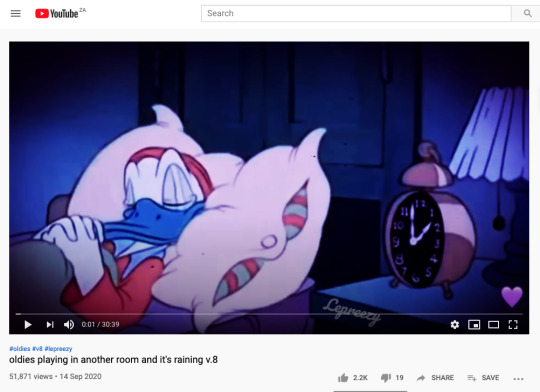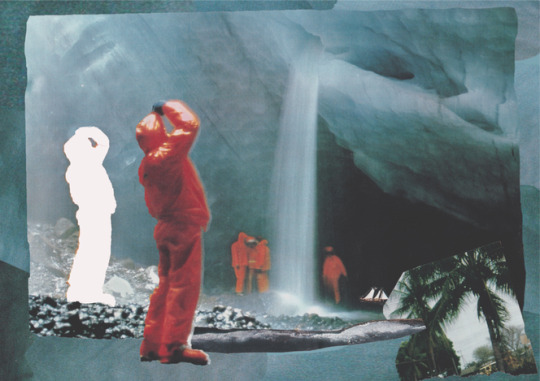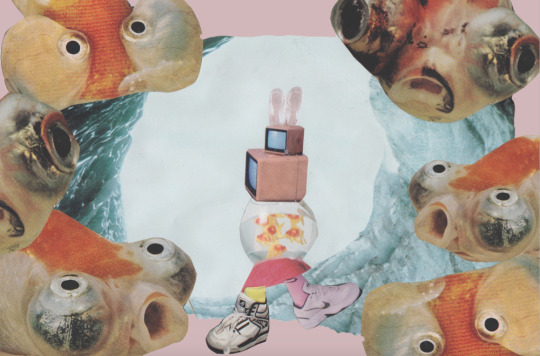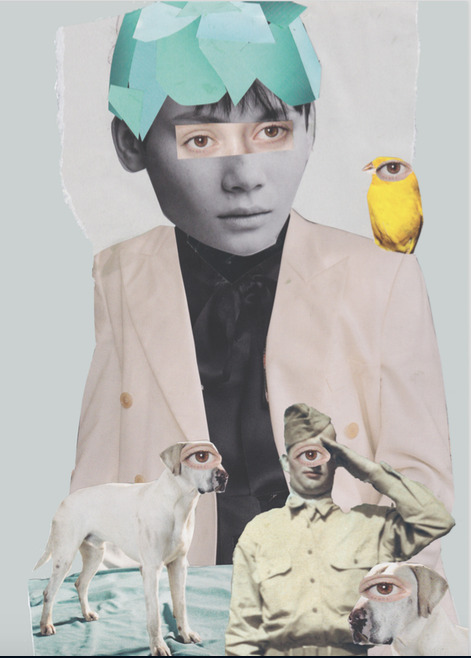Text
Tissue Sample
https://drive.google.com/drive/folders/1irgD8bR2P_jKteopwu_nAF1zfhrSfVSk?usp=sharing
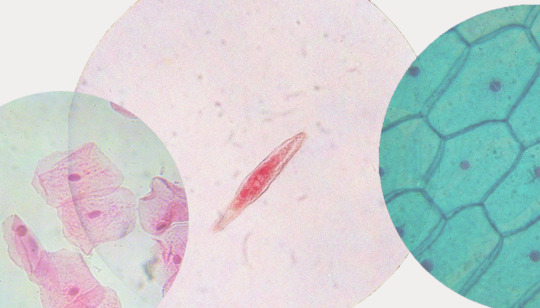
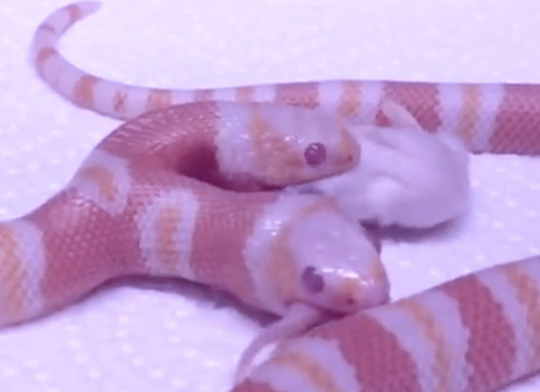
Tissue Sample 2020 Stained glass and video installation 60 x 83 cm
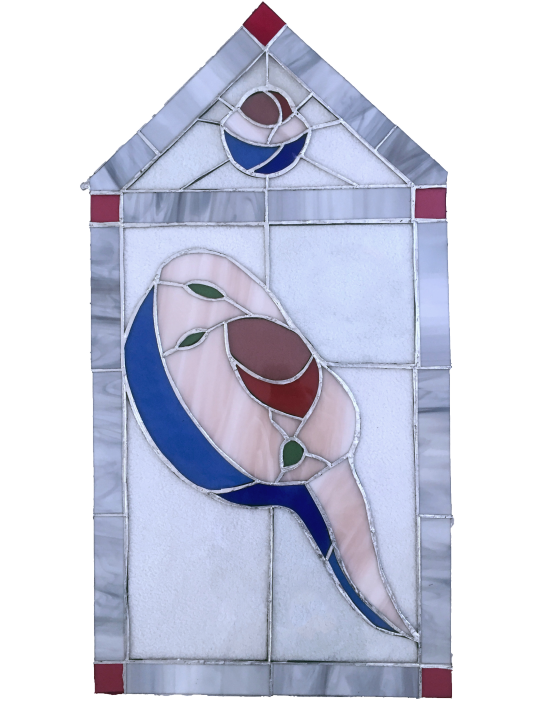
Tissue Sample 2020 Stained glass and video installation 60 x 83 cm
STATEMENT
Under the microscope and through the glass, this work examines transbiology and tissue touches. It plays between solid form and software; wet tissue and cold glass; pink and blue; liquid and light.
The video tells an amorphous and abstracted story about transferred tissue and distorted form: a spinach leaf made of heart tissue, a human ear grown on a mouse. It looks at cell divisions and cell collectives, expanding microbes to the size of the screen.
The window alone and unframed is an arbitrary object. I’m not sure how effective or resolved this work is as an art object, but the process of experimentation and play feels successful. It was an immersive practice, and involved a stretching of my body to unknown and uncomfortable places. I’m glad to be learning an approach to art making that involves asking “How does this work?” and “How could I do that?”. Much of my vision for this work was degraded by technical constraints, but it was a good learning curve bumping up against those constraints and feeling how far I could push them.
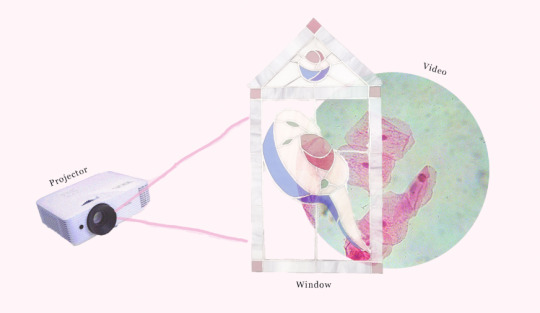
CURATION
It is hard to capture in photographs how light moves through coloured glass. When light shines through the stained glass it functions like a basic projector, casting an image of itself onto the surface behind it.
At home I have played with showing the video through the window, with the pieces of coloured glass acting like filters. In light, colours mix fluidly like liquid. A blue image on the screen becomes purple when viewed through red glass.
If I were to show this work in a gallery space I would suspend the window, and project the video through it. It would produce a double projection, with the window’s image transferred over the video. The sections of solder and opaque glass would cast silhouettes across the video. The textured glass creates a mottled light.

MATERIALITY
When I finished the window and started making the video work, I was surprised to find how smooth and easy digital work felt after a week of smashing glass. Returning to the digital realm, the ease with which I could manipulate material was magic. I had felt so frustrated with digital work before this, but having worked with something as physically intense as glass the digital work felt easy.
This material dialogue/ polarity was interesting. In practice, the two processes couldn’t feel more different: fusing glass with solder that gets hot and melts compared to fusing audio clips with layers on the Premier Pro file; cutting the glass compared with cutting footage. They feel so different in your fingers. glass is smooth and sharp and cuts you if you mishandle it. Digital work strains your eyes and cramps your hands. The glass is more obviously brutal, leaving surface injuries. But it also warms in your hand, softens with sandpaper. It didn’t tire me out like digital work does. There is some kind of elemental magic about melting metal and cutting glass, substances that are so unyielding in everyday life.
Despite this severe polarity in the materials, after the making process I found so many conversations between the mediums. When I finished the window and held it up to the light, and saw how it projected itself onto the surface behind it, I felt a powerful dialogue between the two materials. It seemed like they were playing with the same thing: colour and light. Both software and glass are human’s way of manipulating how we see, the latter is just a much older form of technology.

0 notes
Text
Reflection on previous work
Junk Science
Video; audio; sculpture; text; AI; live biological matter; experiment; performance; volcanic reaction; wet; crystals
Rocks
Drawing; video; audio; serial; process; observation; terrestrial; dry
A Cyborg Manifesto: theory reader
Digital; illustrative; dialogue; play; found material
COMPOSITIONS OF PREVIOUS WORKS



DIGITAL MIND MAP

POSTHUMOUS DIALOGUE
https://drive.google.com/drive/folders/11QgeYKXmktOQBxxITvUoDKYT9gwWkZDJ?usp=sharing

0 notes
Text
Material play TD200
a. Speaker

b. Glue

c. Collage

d. Collages & glue

e. Three knots
Slip Knot

Static knot

Stopper knot (I’m proud of this one!)

f. Square lashing

g. Assemblage



0 notes
Text
https://drive.google.com/drive/folders/1bXVLIsl_AxtH8jQmK84-8JR8pbBNm86E?usp=sharing
Junkscience
Junkscience is a cyborg collaboration between an AI, an art student and Lynn Margulis��� digital ghost.
When NASA first asked the scientific community: how can we detect life on other planets? It prompted the question: what is life? They commissioned scientists to produce a Life Detection Apparatus, a device that could detect the living process.
We are 70 years late with our reply.
Our apparatus is nonfunctional. It is a knockoff, a simulation, an artist’s impression.
Junk art collaborating with junk science to produce conglomerate debris.
We have haphazardly and crudely filched material from biologists, geologists, physicists, astronauts, electricians, computer programmers, youtubers, writers and (maybe even) artists.



Script

Software

Symbiotic Interaction

Simulation

Junkscience
Luca Evans
Mixed media, live cultures
2020
2 notes
·
View notes
Text
Junkscience
Junkscience is a cyborg collaboration between an AI, an art student and Lynn Margulis’ digital ghost.
When NASA first asked the scientific community: how can we detect life on other planets? It prompted the question: what is life? They commissioned scientists to produce a Life Detection Apparatus, a device that could detect the living process.
We are 70 years late with our reply.
Our apparatus is nonfunctional. It is a knockoff, a simulation, an artist’s impression.
Junk art collaborating with junk science to produce conglomerate debris.
We have haphazardly and crudely filched material from biologists, geologists, physicists, astronauts, electricians, computer programmers, youtubers, writers and (maybe even) artists.



Script

Software

Symbiotic Interaction

Simulation

Junkscience
Luca Evans
Mixed media, live cultures
2020
2 notes
·
View notes
Text

Library task: bibliography
Delpech, J. & Figueres, M. (2001). The mouldmaker’s handbook. London: A & C Black.
Hobbins, C. (2007). Traditional wooden toys their history and how to make them. Carmarthenshire: Stobart Davies Ltd. Pace, R. (2014). Making simple automata. Wiltshire: The Crowood Press Ltd. Peppé, R. (1980). Rodney Pepé’s moving toys. London: Evans Brothers Ltd.
Rizzoli New York. (2007). Louise Bourgeois. London: Tate Publishing.
Standard Bank Gallery Johannesburg. (2002). The magical universe of Joan Miró. Johannesburg: Standard Bank Gallery.
Stupart, L. (2016). Virus. 2nd ed. London: Arcadia Missa Publications.
0 notes
Text
PP120 curatorial assignment
Part B
Question 1
What does a curator do?
I think a curator’s job is to synthesize a collection of work. Curatorship is about more than just arranging work in an aesthetically pleasing way; it’s about figuring out how the works speak to each other. I think a curator has two main functions: figuring out how the works function together, and figuring out how people will experience them. Curators need to consider how viewing the work will feel for people. Sometimes this can even entail arranging works in an uncomfortable or aesthetically weird/ difficult way. Curatorship can invite passive/ easy viewing or more challenging engagement. What would it mean if you had to crawl through a tunnel to look at a work? What does it evoke in someone if the painting is hung skew, or upside down? Central to curatorship is figuring out the relationships between works, do they juxtapose? Is there conflict or connection?
Question 2
“Junction-maker”
I like this point about Sergei Diaghilev not making their own art but making junctions. Especially in our contemporary time of waste and surplus production the idea of being a junction maker rather than a product maker feels really important.
Role as a catalyst not a rival
The competition between artists can be really discouraging. There’s often this feeling like there’s not enough space to go around. Everyone is afraid of being copied or appearing to imitate other artists. There’s a lot of pressure to be original and to safeguard the little space you carve out for yourself. I like the idea of having a creative role inside another artist’s space without jostling for it or claiming it as your own. It seems like a great way to collaborate with an artist while still giving full space and autonomy to their personal practice.
“Art can appear where we expect it least”
I find the idea of taking art out of galleries really exciting. The gallery circuit in Cape Town seems very driven by an elite and insular group and can feel really inaccessible to a young artist.
Question 3
Okwui Enwesor
Enwesor’s central point is about finding spaces where the curator can “act”. They posit that in order to act you have to have an agenda. I interpret this as an emphasis on spaces where curators can have creative vision that is not determined by show casing work in a sellable or gallery approved way. They say it’s impossible to act in a space like an art fair, for example. They observe: “Every project feels like an interview for a job”
Koyoh Kouoh
Kouoh sees curatorship as a space to shape the canon differently; a way to intervene in a racist and euro-centric art history. They look to connect and transform histories and futures. They discuss connecting the Diaspora through curatorship.
They acknowledge that although many artists do not want to be reduced to identity categories, it is necessary to curate intersectional spaces in shows. They draw attention to the fine line between acceptance and assimilation, with the warning that seeking to blend in will never solve underlying issues. They observe that more important than acceptance is recognition and independence, which will never be given and must be taken, actively, even when those in power do not wish to relinquish it.
Simon Njami
Njami aims to produce a diverse collection. He sees curatorship as an opportunity to teach people. He links curatorship to political leadership, and the necessity of learning effective direction, management and incorporation of voices and visions.
Njami and Kouoh have some similar ideas about curatorship, but Kouoh seems more rigorous/ radical/ active and Njami slightly more idealistic or passive. Perhaps that is because Njami grew up in a European context and Kouoh in Africa. But both share a collectivist approach to curatorship, privileging diversity in their collections. Contrastingly, Enwesor is more focused on the curator as an individual with a personally driven vision.
Part C

“Neutral” arrangement

Placed on the skateboard the objects appear more animated and somehow more connected to each other. They look like they’re going on a journey together.

Placed in the freezer the objects disrupt the functionality of the space in quite an interesting way. It kind of invites a surprise reaction, or the question of why they are placed there.
0 notes
Text
Final Tut Assignment: Tentactualism
If this is hard to read here is a shareable link to a Google Drive folder: https://drive.google.com/open?id=1dXOPK6Dm1MXeJCMowcJ2p8Ae-ayjHd-d


0 notes
Text
SP100 - Self Portrait
Link to my selfie journal: https://youtu.be/7ePAzR5ynVQ
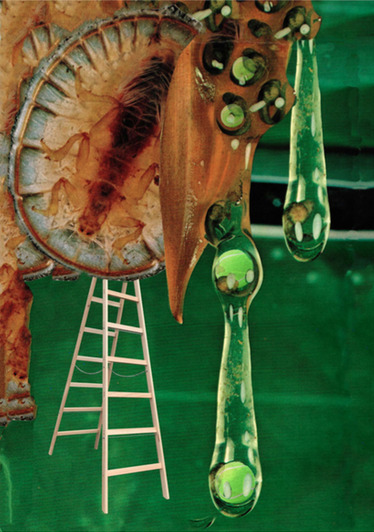
Feel, simultaneously, very scared of falling and a strong impulse to jump

Swerve around all these messed up dogs on the highway
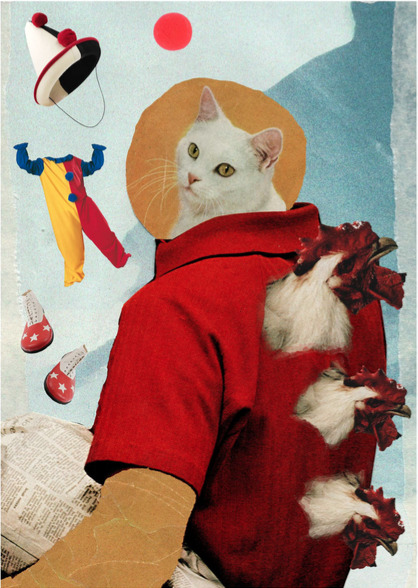
A kit with little pieces to make a clown

Something about a network of pipes
Google drive link: https://drive.google.com/drive/folders/1Uya3z9o0N8kWmUkSEUYosf84dkuoNLgr?usp=sharing
0 notes
Text
Digital drawings: portraits
CYMK self portrait
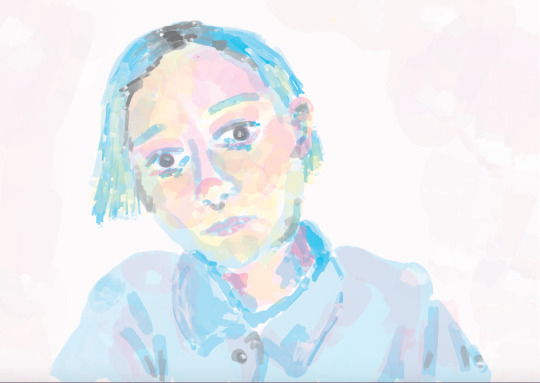
Portrait of two classmates (layered)
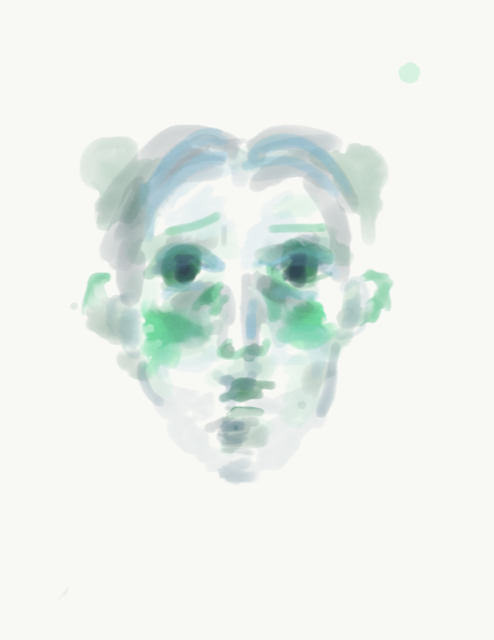
Selfie with merged background

0 notes
Text
Digital archive exercise
Tool practice/play exercise

Original image:

Personal Archive: erasure

Original image:

Personal Archive: addition

Original image:

Public Archive: erasure

Original image:

Public Archive: addition

Original image:

0 notes
Text
Digital References

Untitled composite photographs
Eddie Senze
1944
These composite photographs of Hitler were made in 1944, towards the end of the war. The Office of Strategic Services - a forerunner to the CIA - commissioned these composites from New York based makeup artist Eddie Senze towards the end of the war. The OSS suspected that Hitler might try to escape, and although people were by then very familiar with his distinctive moustache and side parting they might not recognize him under a different guise.
This image has quite a strong impact on me. I am very familiar with the top left image, the “original”, but the other faces of Hitler appear to me like much more “real” people. It is strange how a feeling or perception of reality can be manipulated in the inauthentic. The original photo is so familiar to me that it reads more like an icon or caricature. But the other faces of Hitler look like my uncles or teachers or people in the street. It humanises him in an unnerving way. It’s interesting how photographic manipulation negotiates the murky realm of reality and how it is simultaneously reproduced and produced in that reproduction.
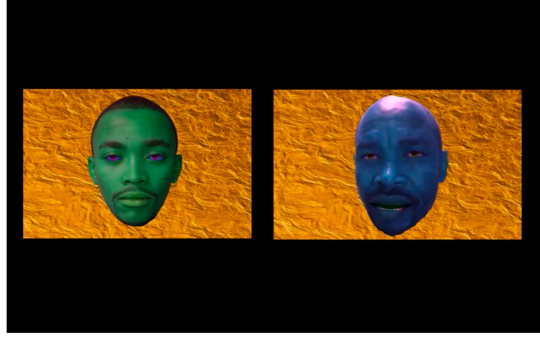

Bogosi Sekhukhuni
Consciousness Engine 2: absentblackfatherbot
2014
Dual channel video
In Bongosi Sekhukhuni’s 2014 work, the absentblackfatherbot, he shows a dual-screen video installation of two floating faces speaking to each other. The video shows a conversation between the artist and his estranged father, with the text based on their real conversations on Facebook messenger. Sekhukhuni reconstructs the interaction using voice software and animated simulations of himself and his father. The voices sound like bots, and there is a funny disconnect between the bot voices and the real content of their conversation.
These strange body-less figures with floating faces and mechanic voices explore an interesting space between digital and material content. It resonates with me how Sekhukhuni incorporates intimate and private content into a physical realm. It explores the idea of how to construct a person through fragments of their digital records, and through their connections with other people.
1 note
·
View note
Text
Digital Justice: tutorial references
Digital Colonialism Threatening the Global South
Aljazeera news
https://www.aljazeera.com/indepth/opinion/digital-colonialism-threatening-global-south-190129140828809.html
Physical Tactics for Digital Colonialism
Morehshin Allahyari
https://www.newmuseum.org/exhibitions/view/morehshin-allahyari-physical-tactics-for-digital-colonialism
Afro Cyber Resistance
Tabita Rezaire
https://vimeo.com/114353901
Invisible Networks
https://www.bbc.co.uk/sounds/play/m000458l
Meet Q: the first genderless voice
https://www.genderlessvoice.com
Can the machine be creative?
Ahmed Elgammal
https://aiartists.org/ahmed-elgammal
I kind of hate most of the ideas in this work but maybe worth thinking about?
0 notes
Text
Video References
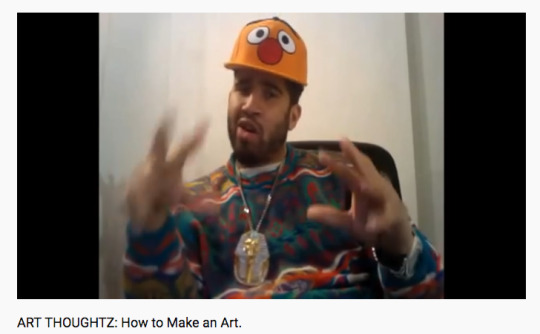
This Hennessy Youngman video provides a narrative reference for a simple “How To” video. The content in the video also applies to my work, as he is providing instruction for people who “can’t” make art. At the end he talks about performance as double art, and ends off saying that if you can’t make art you can always make video art. I like the idea of performance as “double” art because in filming my video in the King Beach Skate Park among PE skateboarders it began to feel as much like a performance piece as a video work. Especially when I was lying on my back taping my feet to my board which a lot of people ended up watching/ glaring/ squinting at.
Link: https://www.youtube.com/watch?v=vVFasyCvEOg
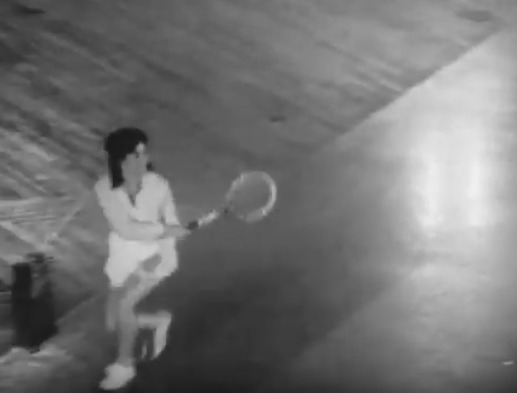
This is a video of Robert Rauschenberg’s 1966 performance piece Open Score which showed a tennis match between two people. The rackets were wired to transmit acoustic transmissions every time they struck the ball, and the lights on the court were also manipulated by the movements of the players.
I like this video of the performance a lot, as it is using a SPORT format. The video is edited much like real footage of a tennis match. The shot bounces from player to player, and at the beginning shows the audience. There is no added sound so all you hear is the noises the rackets make, and the stifled applause of the audience.
There are a few videos of the performance series but I’m just looking at the excerpts from the tennis game.
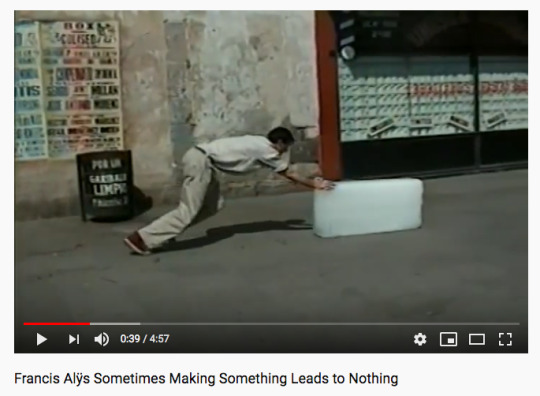
I was excited when we watched this in class the other day because I had seen this video years ago and forgotten about it.
This video serves as a stylistic reference in terms of a “boring” video just showing someone doing something. I like how it shows this long procedure that kind of culminates into nothing. There are these great moments in the film where is genuinely figuring out how to move the ice. Like when he changes from pushing it to kicking it.
It also uses real sounds from the environment. Editing this video I’m tempted to do lots of fancy edits and sound effects because they seem fun and exciting. But watching my footage I actually really enjoy the simple shots with the sounds of the skate park in the background. I enjoy the “silent” moments in the footage where all you can hear is the distant sounds of the environment. It’s hard to be true to that because I’m wary of making a video that’s dull for other people to watch.
0 notes
